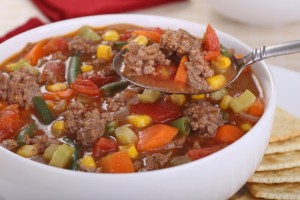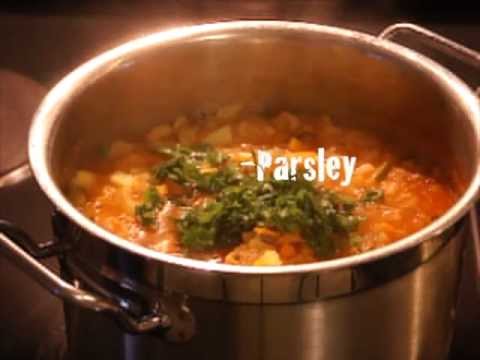Nonna’s Minestrone – OMG – Easy to Follow Recipe
Nonna’s Minestrone – OMG –
Easy to Follow Recipe
This is one of the recipes that I remember as a kid my mom and grandmom used to regularly make for us. Another simple recipe but delicious and very good for us. This is the type of food that kept us healthy and strong. Something we need to get back to these days.
Hope you enjoy this well done video by Aurora Importing…

Minestrone is a thick soup of Italian origin made with vegetables, often with the addition of pasta or rice, sometimes both. Common ingredients include beans, onions, celery, carrots, stock, and tomatoes.
There is no set recipe for minestrone, since it can be usually made out of whatever vegetables one has. It can be vegetarian, contain meat, or contain an animal bone-based stock (such as chicken stock). Angelo Pellegrini, however, argued that the base of minestrone is bean broth, and that borlotti beans (also called Roman beans) “are the beans to use for genuine minestrone”.
Because of its unique origins and the absence of a fixed recipe, minestrone varies widely across Italy depending on traditional cooking times, ingredients, and season. Minestrone ranges from a thick and dense texture with very boiled-down vegetables, to a more brothy soup with large quantities of diced and lightly cooked vegetables; it may also include meats.
In modern Italian there are three words corresponding to the English word soup: zuppa, which is used in the sense of tomato soup, or fish soup; minestra, which is used in the sense of a more substantial soup such as a vegetable soup, and also for “dry” soups, namely pasta dishes; and minestrone, which means a very substantial or large soup or stew, though the meaning has now come to be associated with this particular dish.
Some of the earliest origins of minestrone soup pre-date the expansion of the Latin tribes of Rome into what became the Roman Kingdom (later Roman Republic and Empire), when the local diet was “vegetarian by necessity” and consisted mostly of vegetables, such as onions, lentils, cabbage, garlic, broad beans, mushrooms, carrots, asparagus, and turnips.
During this time, the main dish of a meal would have been pulte, a simple but filling porridge of spelt flour cooked in salt water, to which whatever vegetables that were available would have been added.
It was not until the 2nd century B.C., when Rome had conquered Italy and monopolized the commercial and road networks, that a huge diversity of products flooded the capital and began to change their diet, and by association, the diet of Italy most notably with the more frequent inclusion of meats, including as a stock for soups.
Spelt flour was also removed from soups, as bread had been introduced into the Roman diet by the Greeks, and pulte became a meal largely for the poor.
The ancient Romans recognized the health benefits of a simple or “frugal” diet (from the Latin fruges, the common name given to cereals, vegetables and legumes) and thick vegetable soups and vegetables remained a staple.
Marcus Apicius‘s ancient cookbook De Re Coquinaria described polus, a Roman soup dating back to 30 AD made up of farro, chickpeas, and favabeans, with onions, garlic, lard, and greens thrown in.
As eating habits and ingredients changed in Italy, so did minestrone. Apicius updates the pultes and pulticulae with fancy trimmings such as cooked brains and wine.
The introduction of tomatoes and potatoes from the Americas in the mid-16th century changed the soup by making available two ingredients which have since become staples.
The tradition of not losing rural roots continues today, and minestrone is now known in Italy as belonging to the style of cooking called “cucina povera” (literally “poor kitchen”) meaning dishes that have rustic, rural roots, as opposed to “cucina nobile” or the cooking style of the aristocracy and nobles.
Like many Italian dishes, minestrone was probably originally not a dish made for its own sake. In other words, one did not gather the ingredients of minestrone with the intention of making minestrone. The ingredients were pooled from ingredients for other dishes, often side dishes or contorni plus whatever was left over, rather like the pulte.
There are two schools of thought on when the recipe for minestrone became more formalized. One argues that in the 17th and 18th centuries minestrone emerged as a soup using exclusively fresh vegetables and was made for its own sake (meaning it no longer relied on left-overs), while the other school of thought argues that the dish had always been prepared exclusively with fresh vegetables for its own sake since the pre-Roman pulte, but the name minestrone lost its meaning of being made with left-overs.
From You Tube
Ingredients
-
8 cups water
-
2 onions (chopped)
-
1 clove garlic
-
3 tbsps extra virgin olive oil
-
3 celery stalks (finely chopped)
-
2 large carrots (diced)
-
2 cups
-
2 zucchini (diced)
-
3 potatoes (diced)
-
1⁄2 cabbage (finely chopped)
-
1 tbsp
Directions
-
Sauté onions & garlic in olive oil & 1 cup of the water
-
Cook for 3-4 min. until translucent over med/low heat
-
Add carrots, celery & additional 1 cup water & simmer 5 min.
-
Mix in strained tomatoes, zucchini & potatoes
-
Add 2 more cups water & simmer additional 5 min.
-
Chop & stir in *cabbage with remaining 4 cups water
-
Add salt to taste & let simmer 25-30 min.
-
Add parsley & drizzle with oil & serve
-
Nonna Tip: *Substitute cabbage with 2 cups cooked squash
-
if desired. Add cooked beans and/or cooked small
-
pasta cut (or cooked farro) for another variation.
This site contains product affiliate links. We may receive a commission if you make a purchase after clicking on one of these links.

